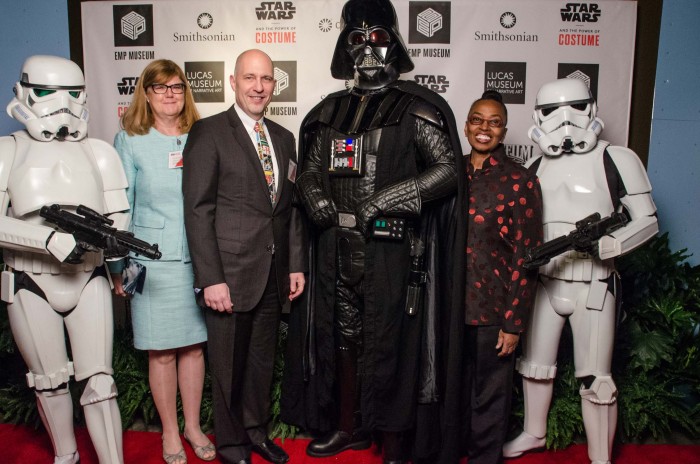Oh, the places we’ll go!

From left, unidentified Imperial stormtrooper; Myriam Springuel, interim director of the Smithsonian Traveling Exhibition Service; Acting Secretary Al Horvath; Supreme Commander of the Imperial Forces Darth Vader; Claudine Brown, Assistant Secretary for Education and Access; and an unidentified Imperial stormtrooper. (Photo by Brady Harvey, courtesy of EMP Museum)
I recently attended the world premiere of Rebel, Jedi, Princess, Queen: Star Wars™ and the Power of Costume at Seattle’s EMP Museum. This joint exhibition with the Lucas Museum of Narrative Art features some of the iconic costumes from the Star Wars galaxy and transported me back to my 16-year-old self in 1977. Not only was I surrounded by Darth Vader and Stormtroopers, but I also had the chance to meet Anthony Daniels (C3PO) and Billy Dee Williams (Lando Calrissian). The on-screen magic of Star Wars has inspired countless costume designers, filmmakers, composers, and even astronauts, and this traveling exhibition rekindles that magic to captivate visitors of all ages.
Every year, many inspirational and eye-opening exhibitions like these circulate across the nation and around the world, thanks to the Smithsonian Institution Traveling Exhibition Service (SITES). The program was established in 1951 with funds from the Alice Pike Barney Memorial Fund and a grant from the State Department. Today, SITES is the world’s largest traveling exhibition service. Last year, SITES reached an audience of more than 4.5 million people in 263 cities in all 50 states, the District of Columbia, Australia, Canada, Guam, and Puerto Rico. They did so by sharing exhibitions, providing educational materials to schools and libraries, and traveling its mobile-truck exhibit to museums, libraries, state fairs, veterinarian schools, city parks, and elsewhere.
From telling the stories of decorated Japanese Americans during a time of internment camps on the homefront in American Heroes: Japanese American World War II Nisei Soldiers and the Congressional Gold Medal, to commemorating Rosa Parks’ civil disobedience in 381 Days: The Montgomery Bus Boycott Story, SITES exhibitions have examined important and poignant chapters in American history. One example still on tour is one of the most popular SITES programs, the bilingual exhibition Bittersweet Harvest: The Bracero Program, 1942-1964. Developed with the National Museum of American History, the exhibition illuminates the hardships of millions of Mexican nationals who were a part of the largest guest worker program ever instituted in the United States.

A bracero worker in a California lettuce field circa 1956. (Photo by Leonard Nadel, National Museum of American History)
Two recent SITES exhibitions explore different eras in America’s history. Patios, Pools, & the Invention of the American Backyard, in partnership with the Smithsonian Gardens’ Archives of American Gardens, explores the development of backyards in the boom years after World War II. Archival photographs and magazine ads help illustrate the mid-century prosperity that led to backyards assuming a place of importance in American life, becoming a hub of activity featuring barbecues, gardens, patios, and swimming pools. The exhibition opened at the Eisenhower Presidential Library, Museum, and Boyhood Home in Abilene, Kansas, on March 21, 2015, a fitting start given Ike’s own penchant for grilling.
Another era of great change in the country is explored in Searching for the Seventies: The DOCUMERICA Photography Project, a collaboration between SITES and the National Archives and Records Administration. This exhibition is composed of 90 color photographs taken for an Environmental Protection Agency project called Project DOCUMERICA (1971–1977), intended to document environmental change for good and ill and how people were affected by that change. The exhibition opened Feb. 14, 2015, at the Upcountry History Museum – Furman University, a Smithsonian Affiliate (one of 200 across the country) in Greenville, S.C. It remains on view through May 3, 2015, before continuing on its 15-city national tour.
Our traveling exhibitions reach communities of all sizes. The SITES Museum on Main Street (MoMS) program engages small-town audiences and underserved rural communities through their museums, historical societies, and cultural venues. By partnering with state humanities councils to bring exhibitions to these communities, we can help them showcase their history, culture, and people. In addition to producing the exhibition, MoMS conducts training on educational programming, oral history collection, and exhibition storytelling. A current exhibition in the MoMS series is Hometown Teams: How Sports Shape America that explores our passion for sports of all types, at all levels, whether we watch or compete.

A family enjoying the fruits of harvest at a backyard cook-out, 1960. (Photo by Molly Adams, courtesy of Archives of American Gardens)
This is a tremendous time for the Smithsonian. The ubiquity of advanced technology allows us to reach more people than ever before with digitized versions of our collections available at the click of a mouse or the swipe of a touchscreen. Teachers and students can print copies of our historic objects on 3D printers in the classroom. But nothing compares to seeing the real things that enliven history in an immediate, personal way. By bringing our expertise and artifacts to people who might not have a chance to experience them in the nation’s capital or in New York, SITES is making the Smithsonian real to people everywhere, giving them a glimpse into the lifetime of learning that we have to offer.
Posted: 29 April 2015








